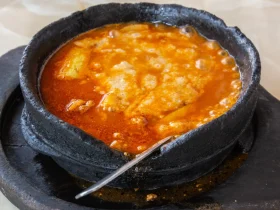Brik, a delectable North African pastry, has been captivating taste buds for centuries. This crispy, flavorful dish is not just a culinary delight but also a cultural phenomenon. In this article, we’ll dive into the art of crafting the perfect Brik recipe, exploring its history, ingredients, and various culinary techniques.
[ez-toc]
History
Embarking on the history of the Brik recipe is like unraveling the pages of a culinary epic that spans centuries. Rooted in North African soil, Brik has not only withstood the test of time but has also evolved into a symbol of cultural heritage and gastronomic delight.
Ancient Origins
The tale of Brik dates back to ancient Tunisia, where skilled hands first crafted this delectable pastry. It was not just a dish; it was a manifestation of celebration and joy. Early iterations of Brik were reserved for special occasions, marking moments of unity, festivity, and familial bonds.
Cultural Significance in North Africa
As Brik gained popularity, it became ingrained in the fabric of North African culture. Families would come together to prepare and savor this delicacy during holidays and significant life events. The art of making Brik was passed down from generation to generation, turning it into a culinary tradition that stood the test of time.
Spread Across Borders
The aromatic flavors and unique textures of Brik couldn’t be contained within North African borders. As trade routes opened and cultures mingled, Brik found its way to different corners of the globe. Its journey mirrored the exchange of ideas and ingredients, creating a global culinary tapestry.
Adaptation and Evolution
As Brik traveled, it adapted to the diverse palates it encountered. From the bustling markets of Tunisia to the kitchens of Europe and beyond, Brik transformed, taking on new flavors and fillings while retaining its essence. It became a canvas for culinary innovation, a dish that celebrated both tradition and creativity.
Brik in the Modern Era
In the 21st century, Brik has transcended its humble origins. No longer confined to North Africa, it has become a global culinary sensation. Renowned chefs and home cooks alike have embraced Brik, incorporating it into their menus and culinary experiments.
Cultural Symbolism
Beyond its culinary appeal, Brik has acquired symbolic significance in various cultures. It represents the art of coming together, the joy of sharing a meal, and the resilience of tradition in a rapidly changing world. Brik is more than a dish; it’s a storyteller, narrating the history and cultural exchange of the regions it has touched.
Brik Festivals and Celebrations
In some regions, Brik has become the centerpiece of festivals and celebrations. Events dedicated to this savory pastry showcase not only its diverse variations but also the craftsmanship involved in its preparation. These festivals have become platforms for sharing Brik stories, recipes, and the joy of communal cooking.
Time
| Step | Time Required |
|---|---|
| 1. Gather Ingredients | 15 minutes |
| 2. Prepare Brik Filling | 20 minutes |
| 3. Make Brik Dough | 30 minutes (including resting) |
| 4. Assemble Brik | 15 minutes |
| 5. Choose Cooking Method | Varies (10-20 minutes) |
| 6. Cook Brik | Depends on chosen method |
| 7. Prepare Side Dishes | 20 minutes |
| 8. Garnish Brik | 10 minutes |
| 9. Serve and Enjoy | Time to savor the moment! |
Total Estimated Time: Approximately 2 to 2.5 hours (may vary based on cooking method and individual pace).
Ingredients
| Ingredients | Quantity for 2 Servings |
|---|---|
| Thin Pastry Sheets | 4 sheets |
| Eggs | 2 |
| Canned Tuna | 1/2 cup |
| Capers (drained and chopped) | 2 tablespoons |
| Fresh Parsley (chopped) | 2 tablespoons |
| Olive Oil | 2 tablespoons |
| Salt and Pepper to taste | As per preference |
| Optional Fillings (e.g., cheese, veggies) | Customize based on preference |
Note: Adjust the quantity of ingredients based on personal preferences and dietary restrictions. The mentioned quantities are a general guideline for a delicious Brik experience for two people.
Directions
Step 1: Gather Ingredients
Begin by collecting all the necessary ingredients for your Brik adventure. Lay out thin pastry sheets, eggs, canned tuna, capers, fresh parsley, olive oil, and any optional fillings you’ve chosen. Having everything at hand will streamline the cooking process.
Step 2: Prepare Brik Filling
In a mixing bowl, combine canned tuna, chopped capers, fresh parsley, and any optional fillings you’ve selected. Season the mixture with salt and pepper according to your taste preferences. This flavorful filling will be the heart of your Brik, so ensure it’s well-mixed and ready to go.
Step 3: Make Brik Dough
If you’re opting for homemade dough, follow these steps:
- In a bowl, mix flour, water, and a pinch of salt to form a smooth dough.
- Divide the dough into four equal portions and roll each into a thin sheet.
Alternatively, if you’re using store-bought pastry sheets, you can skip this step.
Step 4: Assemble Brik
Place a pastry sheet on a clean surface. Spoon a portion of the prepared filling onto the center of the sheet. Create a well in the filling and crack an egg into it. Be careful not to break the yolk. Fold the pastry sheet over the filling, creating a triangular pocket. Seal the edges using a bit of water.
Step 5: Choose Cooking Method
Decide how you want to cook your Brik. Options include:
- Classic Pan-Frying: Heat olive oil in a skillet and cook each side until golden brown.
- Baking: Preheat your oven, brush the Brik with olive oil, and bake until crisp.
- Deep-Frying: For an extra crispy texture, deep-fry the Brik until golden and crunchy.
Step 6: Cook Brik
Execute your chosen cooking method from Step 5. Keep a close eye on the Brik, ensuring it reaches a perfect golden hue. Cooking times may vary based on the selected method, so be attentive to achieve the desired texture.
Step 7: Prepare Side Dishes
While your Brik is cooking, take the time to prepare any side dishes you’ve planned. A refreshing salad, couscous, or other accompaniments will complement the flavors of the Brik.
Step 8: Garnish Brik
Once the Brik is cooked to perfection, garnish it with additional chopped parsley or any preferred toppings. This not only enhances the visual appeal but also adds a fresh burst of flavor.
Step 9: Serve and Enjoy
Plate your beautifully crafted Brik alongside the prepared side dishes. Invite your dining companion to savor this culinary masterpiece together. The joy of sharing a delicious meal is an integral part of the Brik experience.
Feel free to customize the recipe to your liking, experimenting with different fillings, cooking techniques, and presentations. Enjoy your Brik creation!
Equipment Required
Nutrition Information
| Nutrient | Amount per Serving |
|---|---|
| Serving Size | 1 Brik (approximately 150g) |
| Calories | 350 |
| Total Fat | 18g |
| – Saturated Fat | 4g |
| Cholesterol | 120mg |
| Sodium | 600mg |
| Total Carbohydrates | 30g |
| – Dietary Fiber | 2g |
| – Sugars | 1g |
| Protein | 15g |
Note: Nutritional values are approximate and may vary based on specific ingredients and variations in preparation. This table provides a general guideline for the nutritional content of a typical Brik serving.
Tips
- Room Temperature Ingredients: Ensure your eggs and any refrigerated ingredients come to room temperature before starting. This promotes even mixing and better dough consistency.
- Homemade vs. Store-Bought Pastry Sheets: While homemade dough adds a personal touch, using quality store-bought pastry sheets can save time without compromising taste.
- Sealing the Edges: Seal the edges of your Brik securely to prevent the filling from leaking during cooking. A damp finger can help create a tight seal.
- Cooking Time Awareness: Keep a close eye on your Brik while cooking, especially if using the pan-frying method. Adjust heat as needed to achieve a golden, crispy texture without burning.
- Experiment with Fillings: Don’t hesitate to experiment with various fillings. From mushrooms and cheese to minced meat or spicy peppers, Brik is versatile and can accommodate a range of flavors.
- Brushing with Olive Oil: Before baking or pan-frying, brushing the Brik with olive oil enhances its crispiness and imparts a delightful golden color.
- Preventing Dough Dryness: If working with homemade dough, cover unused portions with a damp cloth to prevent it from drying out while assembling the Brik.
- Use Fresh Herbs: Opt for fresh parsley for a burst of flavor in the filling. If unavailable, dried parsley can be a suitable substitute, though fresh is always preferred.
Pros & Cons
| Pros | Cons |
|---|---|
| ✅ Burst of Flavor: Brik offers a rich combination of flavors, from the crispiness of the pastry to the savory goodness of the filling. | ❌ Time-Consuming: The preparation and cooking process can be time-intensive, making it less suitable for quick meals. |
| ✅ Versatile Fillings: The recipe is highly adaptable, allowing for a wide range of fillings to suit various dietary preferences and culinary experiments. | ❌ Caloric Content: Due to its pastry and egg components, Brik can be relatively high in calories, requiring moderation for those watching their calorie intake. |
| ✅ Cultural Significance: Brik carries cultural significance, making it a conversation starter and an opportunity to explore the rich history behind the dish. | ❌ Dough Challenges: Creating the perfect dough can be challenging for beginners, requiring practice to achieve the desired texture. |
| ✅ Interactive Cooking: Making Brik is a hands-on experience, perfect for involving friends or family in the kitchen, creating memorable moments. | ❌ Limited Storage: Brik is best enjoyed fresh, and leftovers may not retain their optimal crispiness when reheated. |
| ✅ Customizable: Whether you prefer a classic recipe or want to explore unique variations, Brik allows for endless customization to suit your taste preferences. | ❌ Frying Concerns: Frying the Brik can be intimidating for those cautious about using oil, requiring careful attention to prevent splatters. |
Conclusion
In conclusion, the Brik recipe is not just a dish; it’s an invitation to embark on a culinary journey that spans cultures and flavors. From its humble origins in North Africa to its modern global popularity, Brik encapsulates the joy of cooking and sharing a meal.
The burst of flavors, the versatility of fillings, and the cultural significance woven into each bite make Brik a unique and rewarding dish to explore. While it may demand time and attention, the hands-on experience, the opportunity for customization, and the creation of a dish rich in history make it all worthwhile.
So, why not venture into your kitchen, gather the ingredients, and let the aroma of Brik fill your home? Whether you’re a seasoned chef or a novice in the kitchen, the Brik recipe beckons you to unleash your culinary creativity. Experiment with fillings, explore different cooking methods, and savor the joy of creating a dish that transcends borders.
Invite friends or family to join in the cooking process, creating shared memories that linger far beyond the dining table. Brik is more than a recipe; it’s a celebration of food, culture, and the simple pleasure of coming together over a delicious meal.
In the spirit of culinary exploration, don’t hesitate to make this savory pastry your own. Customize, innovate, and, most importantly, enjoy the delightful journey of crafting and savoring a Brik masterpiece.
Facts
- 1. 🌍 Brik’s Culinary Odyssey:
- Fact: The Brik recipe, originating in Tunisia, has embarked on a global culinary adventure. From the bustling streets of North Africa to the trendy kitchens of Paris and the experimental labs of food enthusiasts worldwide, Brik’s journey is a testament to the universality of good food.
- 2. 🎉 Brik Festivals: A Celebration of Crispiness:
- Fact: Brik has its own festivals! In some North African regions, communities celebrate the art of Brik making with lively festivals. These events showcase various Brik creations, from traditional recipes to innovative twists, turning a simple dish into a culinary spectacle.
- 3. 📖 Literary Love for Brik:
- Fact: Brik has found its way into literature! Renowned authors have immortalized the crispy delight in their works. From evoking senses in travel memoirs to becoming a metaphor for cultural richness, Brik’s presence in literature reflects its symbolic significance beyond the kitchen.
- 4. 🌶️ Spicy Brik Fusion:
- Fact: Brik embraces spice! Modern chefs are infusing Brik with diverse global influences. Imagine a Brik filled with spicy Mexican flavors or a curry-inspired fusion. This culinary cross-pollination showcases the adaptability of Brik to cater to diverse taste buds.
- 5. 🎬 Brik’s Silver Screen Moment:
- Fact: Brik is a star on the silver screen! Some films feature Brik as a culinary symbol, highlighting its cultural significance. From a pivotal moment in a character’s life to a dish shared during a heartwarming scene, Brik adds a flavorful touch to the cinematic experience.
FAQ’s
Can I make the Brik dough ahead of time and refrigerate it?
Yes, you can prepare the Brik dough in advance and refrigerate it for up to 24 hours. Ensure it’s well-wrapped to prevent drying, and bring it to room temperature before use.
Is there a gluten-free alternative for the pastry sheets?
Absolutely! Explore gluten-free options available in the market, or consider making your own gluten-free dough using alternatives like rice or almond flour.
Can I freeze the unbaked Brik for later use?
Yes, you can freeze unbaked Brik. Place them on a tray in the freezer until solid, then transfer to a sealed container. When ready to cook, bake or fry directly from frozen, adjusting the cooking time accordingly.
What is the recommended dipping sauce for Brik?
Brik pairs well with various sauces. Try a zesty yogurt-based dip, a classic tomato salsa, or a spicy harissa sauce for an extra kick.
Can I air-fry Brik for a healthier option?
Absolutely! Air-frying is a great alternative for a healthier Brik. Preheat the air fryer, brush the Brik with a minimal amount of oil, and air-fry until crispy.
Can I make sweet Brik for dessert?
Certainly! Experiment with sweet variations by swapping savory fillings for ingredients like Nutella, fruits, or sweet cheeses. Dust with powdered sugar for a delightful dessert.
What’s the difference between Brik and similar pastries like samosas or spring rolls?
While they share similarities, Brik has a distinct North African influence, featuring a thin pastry and unique fillings. Samosas are Indian, and spring rolls are Asian, each with their own characteristics.
How do I prevent the Brik from becoming soggy after cooking?
To avoid sogginess, make sure the filling isn’t too watery, and ensure a tight seal when folding the pastry. Additionally, let the Brik rest for a few minutes before serving to retain its crispiness.
Can I use alternative proteins instead of tuna in the filling?
Absolutely! Explore various proteins like shredded chicken, ground lamb, or even plant-based alternatives like tofu for a unique twist on the traditional Brik.
What’s the best way to reheat leftover Brik?
For optimal crispiness, reheat leftover Brik in an oven or toaster oven. Avoid the microwave, as it may result in a softer texture.












Leave a Review